|
In an initially unspecified woodland, a man armed with a shotgun and accompanied by four dogs is on the hunt for something or someone, while other armed men watch him attentively from positions of concealment. What or who is the lone man hunting? And who are the other men and why are they secreted? Are they working with the first man or waiting to ambush him? Suddenly, the dogs catch a scent and run downhill at top speed with their guardian in rapid pursuit, action captured in a series of breathless, locked-on-the-subject panning shots. When the man comes to a halt, he raises his gun and fires, and a deer falls dead under the impact of his second shell. Seconds later, the previously watching men join the hunter and together they carry off and prepare the deer for cooking, a meal that they share before silently going their separate ways. As they build a fire, a narrator reveals that they are shepherds from the town of Orgosolo in Sardinia, that their lives revolve around the seasonal search of pasture and water, and that they live by their own moral code, one dictated by the bonds of family and friendship. The sole connection they have to modern civilisation is the rifle, which they use for hunting and for self-defence but also for assault, as almost without realising, they can become bandits.
The hunter's name is Michele, and his life revolves around a flock of sheep that he has yet to finish paying for and that he minds with his young brother Peppeddu, and the two work out of a small stone-walled shelter on the plain on which their animals currently graze. One day, Michele spots two men herding pigs into a place of concealment and setting up camp at his shack, and he quickly surmises that the pigs have been stolen and that the men are bandits. Although not wanting to become involved in anything illegal – he even declines their offer of cooked pork on the basis that it could potentially incriminate him – he unhappily tolerates their presence in the hope that they will soon be moving on, being sympathetic to the fact that they were also once shepherds and have since fallen on desperate times. It turns out that the only reason they are resting up here is that a third member of their party has been injured and is lying inside the shack and currently unable to travel unassisted.
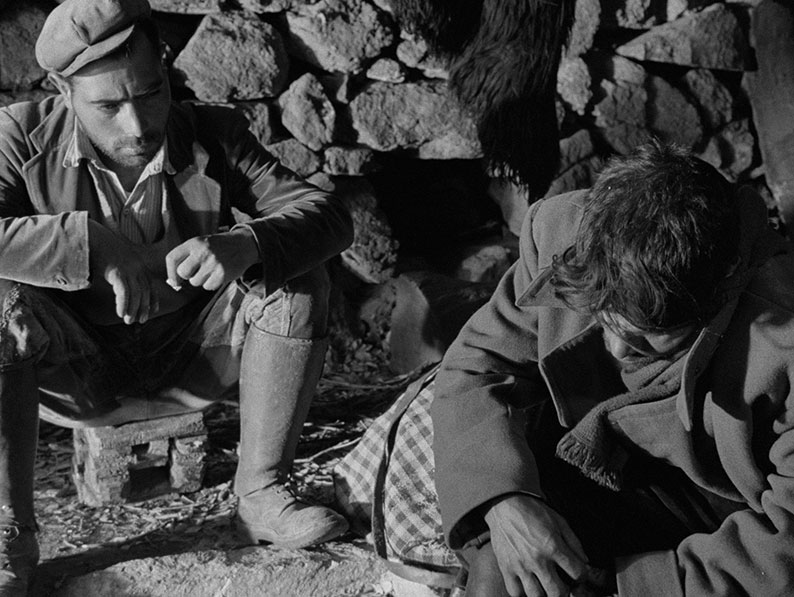
A couple of days later, as the injured man is assuring Michelle that his health is improving and that the three of them will soon be on their way, his companions sound the alarm, having spotted a group of carabinieri heading in their direction. They thus grab the injured man and hastily make their way up the hillside into the rocks above the shack and out of view of the advancing carabinieri. Michele hurriedly conceals a pig head that the men left behind in their haste to depart, and when the carabinieri arrive and question him about these three individuals, out of empathy for their plight he humbly claims not to have seen them. Clearly not convinced, the lead officer orders his men to search the shack and the surrounding area. When one of the men discovers the pig's head, Michele claims that he bought it for food, an unconvincing story for a man of his obviously meagre means. When the carabinieri then discover the hidden pigs, Michele has no response, and when the bandits are spotted and a gun battle ensues, he takes the opportunity to rapidly flee the scene. He quickly seeks out his brother and the two drive their sheep to a remote mountaintop location, and when night falls, Michele leaves young Peppeddu in charge of the flock in order to sneak into town to secure some supplies. With the carabinieri patrolling the otherwise empty streets, he quietly makes his way the house of fellow shepherd Gonario, who reveals that the three bandits are still at large and that they shot and killed one of the carabinieri, and now Michele is presumed to be part of their gang and is being urgently hunted on a charge of murder.
It's perhaps because of the justifiable prominence of several Italian neorealist key titles that there's a tendency to associate the genre with urban city stories and/or those set during or immediately following the Second World War – think Vittorio De Sica's Bicycle Thieves [Ladri di biciclette] (1948) and Umberto D. (1952), or Roberto Rossellini's Rome, Open City [Roma città aperta] (1945), Paisan [Paisà] (1946) and Germany Year Zero [Germania anno zero] (1948). In the wake of these films, former architectural student Vittorio De Seta was working as an assistant director but became unhappy with the way working people of Southern Italy were being portrayed in post-neorealist Italian cinema. His response was to buy his own camera and film stock and begin documenting their lives and professions with an observational acuity and unforced poetry that attracted critical praise and won festival prizes. It was from one of these films, the 1958 Orgosolo's Shepherds [Pastori di Orgosolo], that the idea for Bandits of Orgosolo [Banditi a Orgosolo] first grew.
While the storyline here is a fictionalised one, its factual inspiration is set up in an introductory caption on Orgosolo's Shepherds that states, "This is the Sopramonte di Orgosolo in Sardinia, once a refuge for fugitives and bandits." The connection to reality doesn't end there. What I was unaware of until I dived into the special features on this release is that there are no professional actors in the film, with the shepherds and their families played instead by the actual shepherds and people of the region. Sure, the performances are defined more by their low-key restraint than their emotional expressiveness, but there's a naturalism to them that feels utterly authentic and true to the characters they play, people for whom simple survival dictates that their response to any crisis is driven more by level-headed rationality than emotion. This results in characters that feel utterly real for the simple reason that they are essentially are, with the result that it becomes disarmingly easy to empathise with Michele's fate, despite the surface coolness of his demeanour. Our bond with him is strengthened by the knowledge that he is wrongly believed to be in league with men who have been driven to banditry by poverty, his decision to stay silent when questioned about them shaped by his appreciation of the hardship that drove them to become rustlers in the first place.
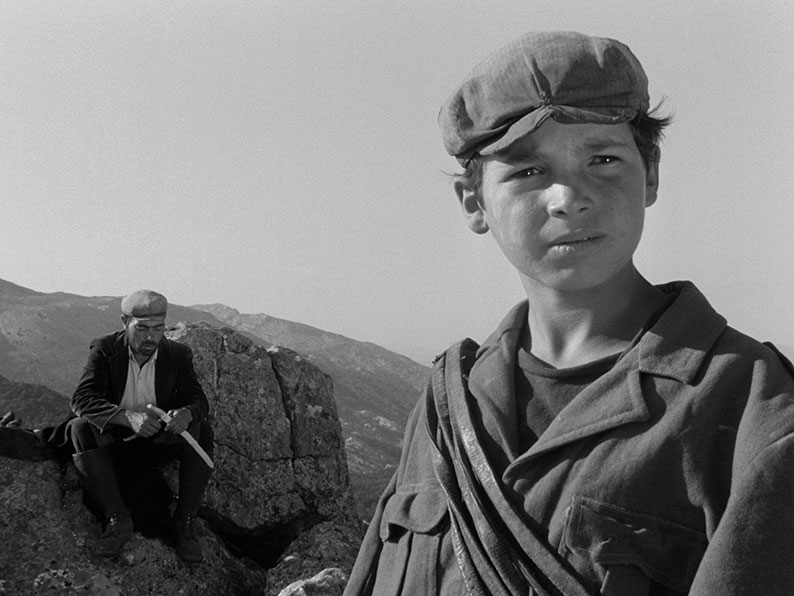
In a landscape whose inhabitants are constantly just one step ahead of destitution and starvation, Michele is a survivor whose true feelings are kept in check by his instinctive pragmatism, and he's far from alone on this score. This becomes clearly evident when he dodges the carabinieri patrolling the town to visit Gonario after moving his flock up into the mountains. Here he dodges Gonario's question about what happened to ask if someone can tell his mother that he is safe, a task Gonario unquestionably assigns to his wife Mintonia, who accepts this potentially risky mission without a whisper of doubt or fear. The following morning, Mintonia once again risks arrest to bring Michele some requested supplies, which he accepts as the instruction for them to leave and let Gonario know where he and Peppeddu will be hiding. He's not being thoughtlessly rude or ungrateful, just coldly practical, something that Mintonia clearly accepts and understands.
Despite his young age, Peppeddu has clearly inherited his older brother's level-headedness and sense of responsibility. When Michele returns their makeshift camp after visiting the town, he confidently puts the boy in charge of the flock, handing him the papers that prove his ownership of the animals and telling him, "You didn't see me, you don't know anything, not even where I went." It's an order that Peppeddu follows to the letter, even when being physically intimidated later by an armed and disbelieving Carabinieri officer. Peppeddu clearly also has his older brother's survival instincts and dedication to the flock that has become their life. When the carabinieri elect to go into hiding in the hope of using capturing Michele by using Peppeddu and the sheep as bait, the boy removes the bells from the necks of the animals and quietly drives them to a location in which they can be effectively concealed, then takes position on a high point where he can observe the frustrated carabinieri without being seen by them. Indeed, as Michele's increasing determination to escape his pursuers and protect his sole asset develops into a self-destructive obsession, it's Peppeddu who becomes the voice of reason and the principal focus for audience empathy.
Despite being his first feature and first narrative-based drama, De Seta directs with the skill of a veteran and tells his story with impeccable economy, an aspect of his filmmaking that is quietly but compelling showcased during Michele's nighttime visit to Gonario. That the carabinieri have been to Michele's mother's house and bullied her for information on her son's whereabout is communicated not through dialogue, but a single wide shot of Mintonia entering the house to find the mother hunched silently over in despair, her living room a wreck of tossed and broken furniture. Meanwhile, back at Gonario's house, we glimpse a rare peek beneath Michele's coolly controlled surface when he is briefly left alone and lets his head slip into his hands in despair, only to then be quietly approached by Gonario's infant daughter, whose attention he responds to with an almost fatherly kindness and concern.
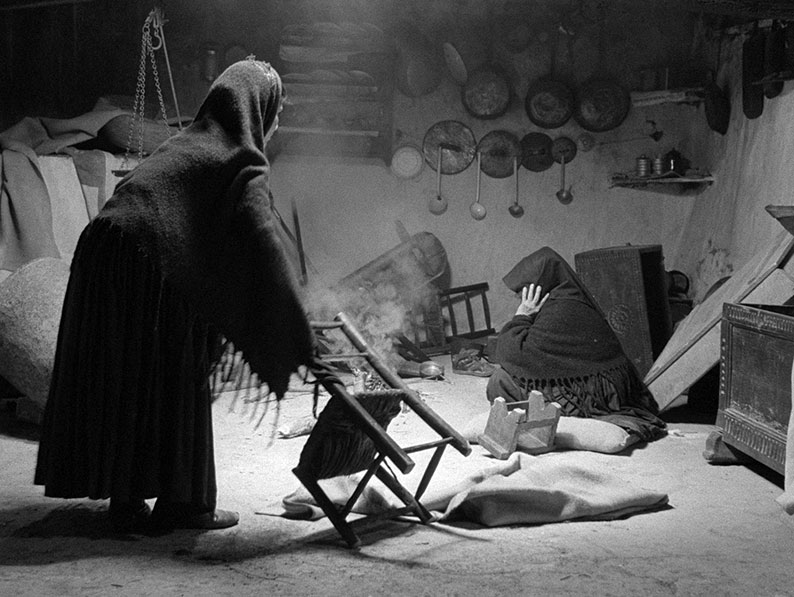
In common with all of the finest Italian neorealist works, Bandits of Orgosolo is both cinematically arresting and absolutely true to its human subjects and its locale. Casting non-professionals as alternate timeline versions of themselves was a risk, but it absolutely pays off here, not least in their casual performance of what for them were everyday activities – Michele making cheese and shearing his sheep, the communal baking bread by the village women at night – that gift the film a genuine ethnographic quality. The storyline may play on what I would hope is a commonly held anger at seeing good people unjustly accused, but its socio-political subtext remains troublingly relevant to this day, and the manner in which it plays out, and where it ultimately leads, make it feel as fresh as the year in which it was made.
For a first dramatic feature by a former documentary director, Bandits of Orgosolo is an astonishing achievement, with De Seta's precise and waste-free direction matched at every turn by his own beautifully composed and expressive monochrome cinematography, ably assisted by future cinematographer of note, Luciano Tovoli. Making the most of De Seta's compositions and economy is editor Jolanda Benvenuti, who had previously cut several acclaimed neorealist features for prominent directors (her notable credits are far too numerous to start listing here), and while carefully rationed, Valentino Bucchi's score is put to subtly effective and sometimes haunting use. In every respect it's a remarkable work that blends drama and documentary to tell a sobering but consistently compelling and character-driven story. Criminally, it rarely seems to get even a mention when Italian neorealism is discussed, a peculiar and frankly unjust state of affairs that I would hope that this most welcome Blu-ray release from Radiance will help address.
Personally, I'd have been happy if the good people at Radiance had elected to release Bandits of Orgosolo as a single Blu-ray with a sprinkling of special features, but instead they have gone the extra mile – and then some – by pairing it with a second Blu-ray featuring ten of the previous documentary works with which Vittorio De Seta first made his name.
As a filmmaker, De Seta was drawn from the start to the lives and the trades of those at the bottom of the social ladder in remote corners of Southern Italy. As a one-man film crew who shot and edited his films largely without assistance, he made of a point embedding himself into the communities in which he planned to film, forming bonds with his subjects that clearly made them far less self-conscious of his camera. He clearly favoured structuring his films around the activities of a single day, often beginning them at dawn and concluding at sunset, or shortly thereafter. Unlike Bandits of Orgosolo, all of these films were shot in colour, and while some are in the expected Academy aspect ratio, others were shot in scope, an unusual format for short documentary films of the day. Being a one-man crew, De Seta was unable to record synchronised sound whilst simultaneously operating the camera, but when not filming he made extensive audio recordings that he used to create authentic soundtracks, often synchronising sounds to actions with a deftness that gives the impression that the audio was recorded live.
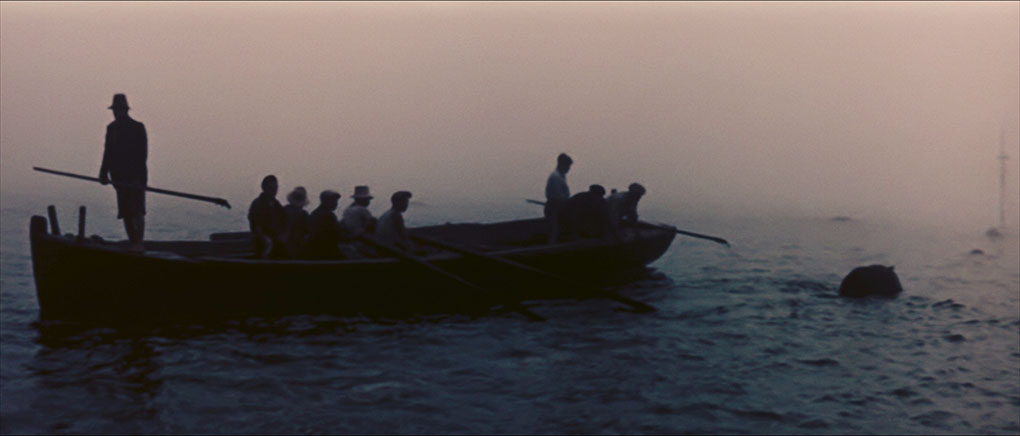
All ten short films here open with two almost identically opening caption screens. The first informs us that the film was restored by Fondfazione Cineteca di Bologna and The Film Foundation at L'Immagine Ritrovata laboratory in 2019, and that funding provided by George Lucas Family Foundation. Yes, that George Lucas. The second states that the film was restored in 4K as part of a collection of ten documentaries directed by Vittoria De Seta, and that depending on the film, the source for the restoration was either the original 35mm camera negative or a second generation internegative, which together with the original sound negative was deposited by the filmmaker with Fondazione Cineceta di Bologna. It also confirms that a 35mm print, restored photochemically in the 1990s with the supervision of Vittorio De Seta, was used as a reference for the editing and colour grading.
Collectively, the ten films have become known as The Lost World, and this disc has the option is play the films individually or consecutively as that single work. I've elected to write a little about each of them and have covered them in the order in which they are listed on the disc, which I gather does differ slightly from the order in which they were made. I'd seen none of them before and was utterly captivated by each and every one of them. Hopefully the following will give a small flavour of why.
THE AGE OF THE SWORDFISH [LU TEMPU DI LI PISCI SPATA] (1955) (10:41)
The first documentary listed here perfectly encapsulates De Seta's favoured single-day, sunrise-to-sunset structure, opening on silhouetted images of swordfishermen heading out to sea at dawn, which is effectively repeated in reverse when they return to land from their endeavours that evening. It soon becomes clear that this form of fishing requires considerable patience, as the fisherman lay quietly in the sun on their boats while one man stands atop a precarious-looking mast keeping lookout for the animals that they are hunting. When he spots one, his companions respond immediately and quickly, and what follows is a brilliantly shot and edited sequence in which they chase the fish, its breathless pace driven by the lookout's constant directional calls. The film concludes with a fireside village gathering in which young children dance with impressive energy and skill to a song sung by their elders. A riveting and impressively compact slice of documentary cinema.
ISLANDS OF FIRE [ISOLE DI FUOCO] (1955) (10:48)
An opening caption revealing that fire still burns beneath Stromboli and other islands that emerge from the sea north of Sicily, and that the threat this poses is prompting islanders to leave, sets the scene for an otherwise wordless portrait of life lived under the threat of potentially disastrous volcanic eruption. General island activities are blended with atmospheric shots of the landscape and staged imagery of individuals reacting to a rising storm and the sounds of an eruption at night (which there is also footage of), only to return to the normality of their daily lives the following morning. An object lesson in how to tell a story through images and sound without the crutch of dialogue or narration.
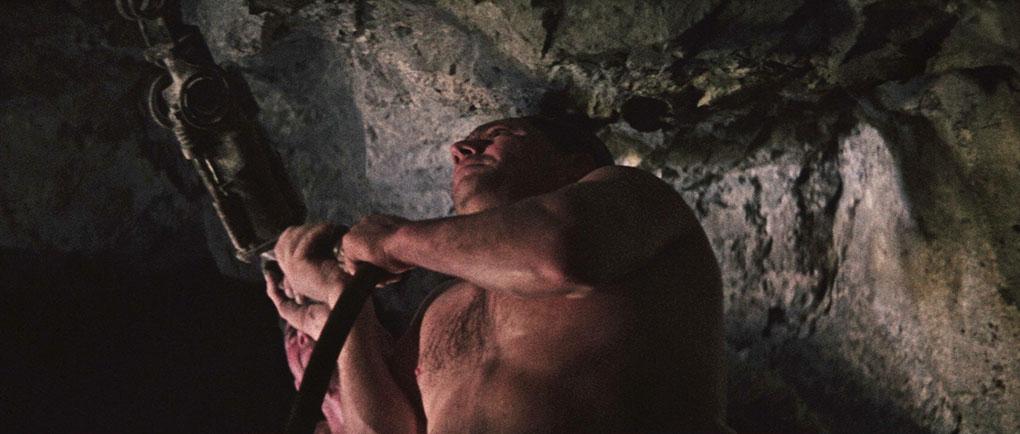
"SURFARARA" (1955) (11:01)
Before playing this film, you're greeted by an on-disc textual introduction revealing that the term "Surfurara" comes from the local dialect of the Caltanisetta, a region famed for its sulphur mines, and that the local Niseni have been referred to by this nickname – which literally means 'sulphur miner' – since the 1800s. What unfolds is a quintessential De Seta documentary, as the miners head out before sunrise, work the mines in conditions that would be considered unthinkable today, and return home as the sun sets, silhouetted against the landscape under which they sunlessly toil. Without explicitly stating what we now know to be true, the film provides stark reminder of just how damaging mine work once was to the health of miners, toiling in near darkness and using jackhammers and chisels to tear rocks from walls that could collapse at any moment, without the aid of goggles or facemasks to protect them from the resulting lung-destroying dust. As the miners work, life on the surface continues, with women washing clothing and linen by hand, men toiling the fields, goods delivered, and neighbours conversing. Then we're back down the mine for a superbly edited sequence that builds in intensity to almost fever pitch, only to be cut dead by an urgent shout that prompts every miner to immediately stop what they are doing and stand motionless in the resulting silence. Another truly remarkable work, and one of several in this set shot in the 2.35:1 aspect ratio.
EASTER IN SICILY [PASQUA IN SICILIA] (1955) (9:53)
A public recreation of the crucifixion and resurrection of Christ meets the climactic parade from The Wicker Man in what for us non-religious types is probably the most unintentionally unsettling film in this collection. This was De Seta's first solo film, one he unfairly dismisses in the interview on this disc as "a fairly banal affair." It does lack the subtextual political punch of his subsequent work, being an uncritical record of two consecutive ceremonies held in the Sicilian towns of San Fratello, Delia and Aidone at Easter, but is still captivating, and the separately recorded sound is well matched to the imagery, which once again was shot in scope, a bold decision for a first solo documentary film.
SEA COUNTRYMEN [CONTADINI DEL MARE] (1955)(10:40)
The wide CinemaScope frame is put to excellent use in this arresting portrait of tuna fishermen living on and working off of the Sicilian coastline on sea routes that the opening caption assures us these fish have taken for millennia. The initial similarities to The Age of Swordfish are perhaps inevitable, beginning as this film does with silhouetted images of the fisherman setting out and preparing their net, then either sleeping or waiting quietly on their boats when day breaks before bursting into action on the call of a spotter when the tuna appear. Without assistance from a commentary, I cannot be sure if the mass raising of hats by the fishermen once the catch is complete is a symbolic tribute to the fish for providing them with food for their families, but I like to think that it is, so I'm going with that. You'll find some of De Seta's most gorgeous cinematography here, and the matching of image and sound is impeccable, though if you find even the sight of a single fish being hooked uncomfortable, you might just want to give this one a pass.
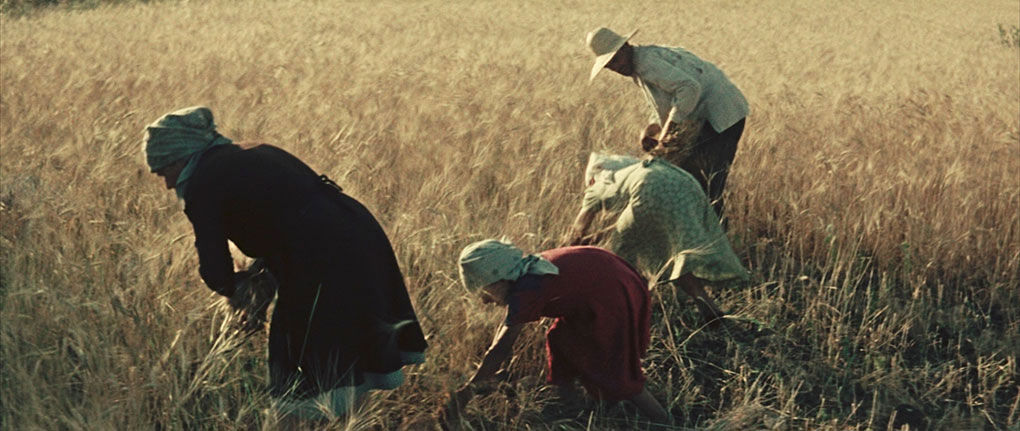
GOLDEN PARABLE [PARABOLA D'ORO] (1955) (10:09)
A fascinating and important record of a manual method of reaping and threshing grain that at the time of filming was still being practised on some parts of the island of Sicily but was very likely in rapid decline even then. It's beautifully filmed and is assembled in a manner that requires no textual explanations to understand the process being shown, at least if you have even a rudimentary understanding of how grain is harvested. The warm, golden hue produced that the Ferraniacolor film stock gives a flavour of the Sicilian summer heat (could we have some of that here, please?) and gives some shots the look of a Millet painting, while De Seta's commitment to getting the shots that he wanted extends to having the harvest at one point tossed directly at his camera – look closely and you'll see grains briefly landing on the rim of the CinemaScope lens. That the film concludes with beautifully picturesque images of the harvesters silhouetted against the sky as the sun sets feels by this point in the collection like the photographic equivalent of De Seta's signature.
FISHING BOATS [PESCHERECCI] (1958) (10:56)
A day in the life of a crew of the many small fishing boats that operated in the waters between Sicily and Africa is the subject of this quietly compelling portrait of a profession that may have since evolved technically, but whose essence remains unchanged, from the long hours required to the unpredictability of the weather and the unforgiving nature of the sea. This and more is clearly conveyed in an economically structured 11 minutes of typically well shot and edited documentary cinema that includes some thunderstorm-enforced downtime and the navigation of some seriously rough seas. In common with The Age of the Swordfish, this one goes beyond sunset to observe the fisherman heading out again on their boats in the blackness of night.
ORGOSOLO'S SHEPHERDS [PASTORI DI ORGOSOLO] (1958) (11:02)
The direct precursor for Bandits of Orgosolo and featuring, I gather, some of the shepherds who had acting roles in the subsequent feature, this can be viewed retrospectively as an essential companion piece, a scene-setting primer, or even a trial run for the film that was soon to follow. The harshness of life for a shepherd in the mountains overlooking the village of Orgosolo is evident in the desolate landscape in which they manage their flocks, where branches are cut from tall trees for bonfires to ward off the winter cold and fuel fires over which the shepherds make cheese from the milk of their goats. It's a fascinating process that is also performed by Michele in the later feature, one of several elements here that testify to the authenticity of so much of Bandits of Orgosolo.
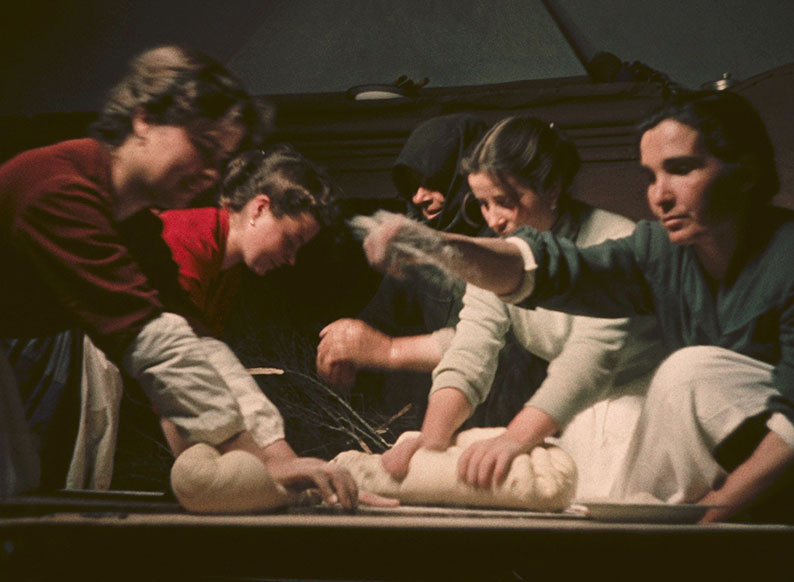
A DAY IN BARBAGIA [UN GIORNO IN BARBAGIA] (1958)(10:49)
What plays as a companion piece to Orgosolo's Shepherds focusses on the women of Barbagia, the large region of Sardinia in which the villages of Orgosolo, Oliena and Mamoiada are located. With the men away in the mountains tending their flocks, it's left to their wives to tend to the houses, crops and families in their absence, and while the environment may be less hostile in the valley villages than up in the mountains, I'd argue that the women have the far tougher job. Quelle surprise. As well as looking after the village children, they are shown washing clothing and linen on rocks by the river and kneading dough by hand to bake bread in ovens that they have to fuel by hacking down small tress on the hillside, then carrying large bundles of wood home balanced on their heads. They also manually work the soil in the fields with hoes, pick fruit from the orchards, sew up holes in clothing, and probably a whole lot more besides. The baking of bread is a particularly enthralling sequence, a communal activity where the women all work together like components of a perfectly engineered machine. It's another scene that makes its way into Bandits of Orgoslolo, where one of the wives assures Michele that the process will take them most of the night.
THE FORGOTTEN [I DIMENTICATI] (1959) (20:39)
The longest film in this collection and the only one accompanied by intermittent narration takes us to the remote mountain village of Alessandria del Carretto in Calabria, which at the time of filming was home to 1,600 men, women and children. What unfolds is effectively a film of two untitled chapters of unequal length. In the first we are informed that the construction of a road to the village that was begun ten years earlier was abandoned by the contractors long before completion and left to decay. Now supplies can only be driven part of the way on unfinished mountainside roads to a point where they are collected by villagers, loaded onto pack mules and walked to the distantly located village across 18 kilometres of difficult and sometimes treacherous territory. Seriously, there are times when this looks less like a supply run than an early ascent to the first base camp on Everest. To add insult to injury, transporting the goods this way is so expensive that the cost of some building materials has almost tripled by the time they arrive at their destination. Oh, and when it rains, as it probably does a lot at this elevation, the water runs down the mountain through the village itself, disintegrating land and triggering mudslides. Not, you might think, a particularly cheery place to live. This is directly challenged by the far longer second chapter that follows, which follows the villagers during an annual celebration to mark the arrival of spring, a festival that apparently dates back centuries and, despite the presence of priests and Catholic iconography, has all the hallmarks of a pre-Christian pagan festival. The central activity involves cutting down a tall fir tree, stripping it of its bark and planing down the wood, onto which handles are attached to enable the men to slowly haul this enormously heavy block back to the village up and over steep hills, pausing on route for fireworks and a modest feast. On reaching the village, the original treetop is reattached with wooden stakes and branch ropes, then the whole thing is slowly and precariously hauled erect and secured in place. The purpose? So that the hardiest men of the village can compete to see who can climb to the top, a near-superhuman feat given that you have to make the ascent in your everyday clothes up a dangerously high and smooth-planed block of wood whose circumference is so large that the fingertips of the climbers barely touch when they throw their arms around it. Another extraordinary historical and ethnographic record from a master of the art.
The 1080p transfer of Bandits of Orgosolo was sourced from a new 4K restoration from the original camera negative by The Film Foundation and Cineteca di Bologna at L'Immagine Ritrovata laboratory, in association with Titanus with funding provided by the Hobson/Lucas Family Foundation, and it looks absolutely gorgeous. The picture is often pin-sharp, and the contrast is sublimely graded, with inky black levels and detailed highlights, especially at night, all of which combines to beautifully showcase the expressive compositions of De Seta's consistently superb monochrome cinematography. Framed in the film's original aspect ratio of 1.37:1, the transfer is also free of dust or damage, and a fine film grain is visible.

The Italian Linear PCM 2.0 mono soundtrack has the expected tonal range restrictions, but is otherwise in solid shape, with clear presentation of the dialogue and sound effects, and especially Valentino Bucchi's score. The English subtitles kick on by default but can be switched off if your Italian is up to the job.
The films in The Lost World collection have also been restored, and while the results do not quite match the seriously high standard set by the restoration of the main feature – where De Seta had considerably more control of the framing and lighting and was likely able to use a slower, finer grain film stock – they are still in impressive shape, and the best material really shines.
DISC 1
Ehsan Khoshbakht (11:16)
In the first of two interviews in this set, curator and filmmaker Ehsan Khoshbakht discusses the strengths and importance of Bandits of Orgosolo, how it spearheaded a second act for Italian neorealism, why he believes it's a richer and more powerful film than many of the works in the movement's first wave, and how it in some ways riffs on Vittorio De Sica's masterful Bicycle Thieves [Ladri di biciclette] (1948). He champions editor Valentino Bucchi as one of the unsung heroes of Italian cinema, praises director De Seta's cinematography, and suggests that the brightly lit interior scenes have the feel of scenes from a Carl Dreyer film. A fascinating listen.
Luciano Tovoli (27:48)
Respected cinematographer Luciano Tovoli – whose many credits include The Passenger (1975) for Michelangelo Antonioni, Suspiria (1977) for Dario Argento, and Behind Convent Walls (1978) for Walerian Borowczyk – reveals how as a young graduate of the Centro Sperimentale film school he rejected tradition and was introduced by his good friend, writer-director Giulio Questi, to Vittoria De Seta, who unusually disliked working with people with a film industry background and thus took him on. This is an excellent and hugely informative interview, in which Tovoli reveals much about how Bandits of Orgosolo came about and how it was cast and made, as well as his own role as co-cinematographer with director De Seta, he being solely responsible for the lighting and even filming some shots to De Seta's written specification. He admits to having some initial regrets after suggesting that he be credited on the film only as camera operator, especially when it won four prizes at the Venice Film Festival and was awarded Best Cinematography by the Italian National Syndicate of Film Journalists. He also intriguingly notes that it took De Seta many years to fully acknowledge his contribution on this score.
Trailer (2:53)
A deceptive trailer composed almost solely of clips suggesting that this is a film driven primarily by action and conflict, but it does include quotes from the many positive reviews that greeted the film on its release. It also features shots from the film's climactic scene, so I'd steer clear of this until after viewing the film for the first time.
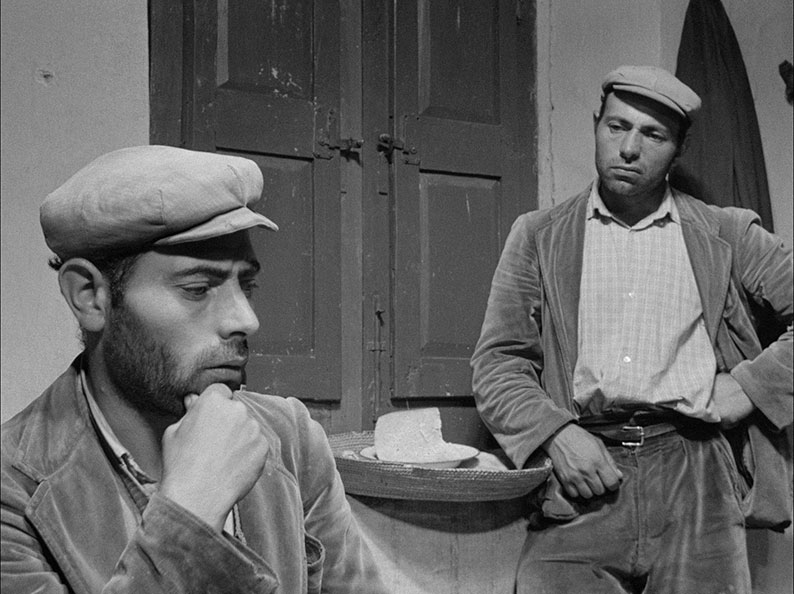
DISC 2
Vittorio De Seta (18:28)
An archival interview with director Vittorio De Seta recorded at the Cineteca di Bologna in 2008, in which the Bandits of Orgosolo director discusses his career as a documentary filmmaker, why he was inspired to portray the lives of working people in Southern Italy, and revealing that, "The idea was to immerse myself in the surroundings and become one of them, building the documentary as I went along." He mourns how economic development has led to the slow death of traditional ways of life and work, and while he admits that the general standard of living has improved, he suggests that the price we have paid was way too high. He also discusses the sunrise-to-sunset structure of his films and goes into some detail about the editing of The Age of Swordfish. A hugely important and enthralling inclusion.
Ehsan Khoshbakht (21:04)
In his second contribution to this release, Khoshbakht examines Vittorio De Seta's work as a documentarian, making the point early on that he is underappreciated and even unknown today, despite his films having been widely seen prize-winners when they were first shown. He looks at De Seta's relatively late entrance into the film industry, initially as an assistant director, and reveals that he decided it was time to make his own films after working on Jean-Paul Le Chanois's 1955 Le village magique, not because he was inspired by the experience, but because he hated the way Sicily was portrayed in the film. He confirms that De Seta was a one-man production crew, directing, photographing and editing all of his documentary shorts without assistance, and goes into some fascinating detail about his process and his use of Ferraniacolor film stock. I'm just skimming the surface of this excellent interview here.
The release disc also includes a Limited Edition Booklet featuring new writing by Roberto Curti, but this was not available for review.
In his second interview in this set, Ehsan Khoshbakh notes that Vittorio De Seta remains an underappreciated and even unknown filmmaker today, and you won't have to look far to find evidence to confirm this statement. I'll freely admit that I was unaware of his work until the announcement of this Radiance release, and while his Wikipedia page is positively anaemic at the time of writing, this online encyclopaedia's Italian Neorealism entry makes no mention of De Seta or Bandits of Orgosolo at all. All hail Radiance, then, for not only releasing De Seta's first dramatic feature in such sparkling condition, but for including a second disc showcasing ten – ten – of the documentary works with which he first made his name, all of which have also been recently restored. Even by Radiance's consistently high standard, this is a belter of a Blu-ray release that is already one of my favourites of 2024, and I cannot recommend it highly enough.
|